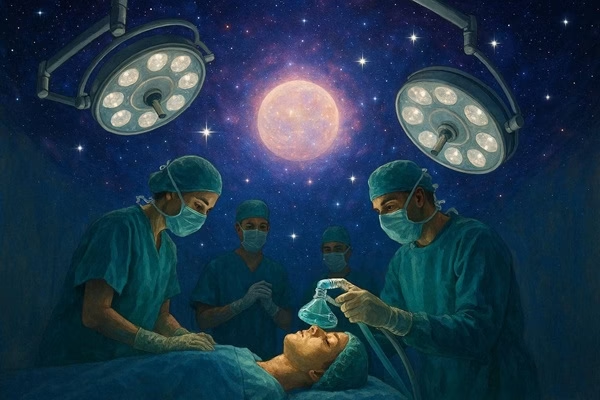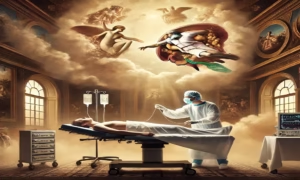The scriptures of major religions do not explicitly describe the use of modern anesthesia, as the concept and technology of anesthesia are relatively recent developments in human history.

However, there are instances in religious texts that describe states of deep sleep, unconsciousness, or divinely induced trances that could be interpreted as analogous to the effects of anesthesia. Here are a few examples:
Judeo-Christianity
“So, the Lord God caused the man to fall into a deep sleep; and while he was sleeping, he took one of the man’s ribs and then closed up the place with flesh.” –Genesis 2:21
This verse is often seen as the first recorded instance of something resembling anesthesia. Before performing the ‘divine surgery’ of creating Eve from Adam’s rib, God placed Adam into a deep, unconscious state, preventing him from feeling pain or distress. This biblical passage highlights the necessity of sedation before medical procedures, a principle that aligns with the modern field of anesthesiology.
In Daniel 10:9, Daniel experiences a deep sleep or trance-like state during a vision, where he loses consciousness and is later revived by a divine being. This could be seen as a form of induced unconsciousness.
Anesthesiology, the medical specialty focused on pain management and surgical sedation, mirrors the processes described above. Just as God ensured Adam’s comfort and safety before performing a procedure, anesthesiologists today use carefully measured medications to render patients unconscious, ensuring they undergo surgery without pain or awareness. These passages not only reflect divine wisdom but also foreshadow the critical role anesthesia plays in medicine, allowing for life-saving interventions while preserving patient well-being. Whether one views it through a spiritual or scientific lens, Genesis 2:21 serves as an early example of the importance of anesthesia in healing and transformation.
Islam
Islamic tradition also contains references that can be linked to the concept of anesthesia, particularly in the story of the creation of Hawwa (Eve) from Adam. While the Qur’an does not provide explicit details about Adam being put into a deep sleep, some Islamic narrations (Hadith and Tafsir) mention that Allah caused Adam to fall into a state of unconsciousness before taking from his side to create Hawwa. This resembles the biblical account and suggests a divine form of sedation before a significant procedure.
Surah Al-Kahf(18:18) describes the story of the People of the Cave (ashaab al-kahf), a group of young believers who sleep for centuries in a cave, protected by God. While this is not anesthesia in the modern senses, their prolonged state of unconsciousness and preservation resembles to what anesthesiologists and intensivists routinely do in the Intensive Care Units (ICUs).
These concepts align with modern anesthesiology, which ensures patients experience no pain or awareness during surgery. Just as Allah, in His wisdom, protected Adam from suffering during this transformative process, anesthesiologists today play a crucial role in safeguarding patients during medical operations. This parallel underscores the deep-rooted human understanding—both spiritual and scientific—that unconsciousness is a necessary condition for major procedures, allowing healing and creation to occur without pain or distress. The connection between divine intervention and medical advancements serves as a reminder of the wisdom behind practices that prioritize human well-being.
Similar concepts can be found in other major religious traditions, particularly in Hinduism and Buddhism, where deep sleep or unconscious states are often linked to transformation, healing, and divine intervention.
Hinduism
In Hinduism, the idea of divine sleep (Yoga Nidra) is significant. One notable example is the creation story in the Vishnu Purana, where Lord Vishnu is depicted as resting in a deep cosmic sleep on the serpent Ananta before the creation of the universe.
“In that water, lying on the bed of the serpent, the Lord [Vishnu], the master of the three worlds, enjoyed his mystic slumber (yoga-nidra). While He was thus asleep, a lotus flower sprouted from His navel.” — Bhagavata Purana, Canto 3, Chapter 8.
This state of deep unconsciousness, known as Yoga Nidra, is not just about rest but also a necessary state before an act of creation or transformation. Similarly, in some interpretations of Hindu mythology, when Shiva creates Parvati from his essence, it is said he enters a deep meditative state, which can be seen as a form of divine anesthesia before a major change.
In the story of King Parikshit in the Mahabharata, the sage Shamika places the king in a state of deep meditation or unconsciousness to protect him from a curse.
This idea resonates with the modern field of anesthesiology, where patients are put into a controlled unconscious state before undergoing life-changing surgeries. Just as Vishnu’s deep rest precedes cosmic creation and transformation, anesthesia allows the body to endure surgical procedures that restore or enhance life.
Buddhism
In Buddhist philosophy, deep states of unconsciousness or trance-like meditation (samadhi) are often associated with healing and transformation. In some Buddhist texts, great masters are described as entering profound meditative states before enduring physical pain or undergoing spiritual rebirth. The concept of parinirvana, which describes the Buddha’s final transcendence into enlightenment, also involves a deep state of unconsciousness before passing into a higher existence.
The story of the Buddha’s enlightenment is recounted in many sutras. As he sat under the Bodhi tree, the demon Mara sent his armies to attack him with weapons and temptations to break his concentration.
“Mara’s soldiers… hurled their weapons… but the weapons… they all turned into celestial flowers… they fell around the Blessed One, like a shower of flowers… The Blessed One was sitting, unconquered, undisturbed.” — Buddhacarita (The Life of the Buddha) by Asvaghosa, Chapter 13
This can be metaphorically linked to anesthesia, where a patient is placed in an unconscious state before experiencing a transformation—whether it be healing, surgery, or recovery. Just as these meditative states are seen as necessary for enlightenment and healing, modern medicine recognizes the need for induced unconsciousness to allow medical miracles to take place without pain or suffering.
Greek Mythology
In the story of Endymion, Endymion is placed in an eternal sleep by Zeus, either as a gift or a punishment. This state of perpetual unconsciousness could be seen as a mythical precursor to the concept of anesthesia.
Modern anesthesia is a medically induced state of temporary loss of sensation or awareness. It has three main components:
- Analgesia: Relief from pain.
- Amnesia: Loss of memory of the event.
- Immobility: Lack of muscle movement.
The divine incidents we’ve explored often share these functional components, albeit through supernatural means.
Connection to Modern Anesthesia:
- The Divine Anesthesiologist: God acts as the ultimate anesthesiologist. He has the knowledge and power to safely induce unconsciousness.

- Induced Unconsciousness: The “deep sleep” (tardema in Hebrew) is not ordinary sleep. It is a divinely induced state of total unconsciousness, ensuring Adam feels no pain and has no memory of the “operation.” This directly parallels the goal of general anesthesia.
- The Surgical Procedure: The extraction of a rib is a significant biological and surgical act. In a conscious state, this would be excruciatingly painful and traumatic. The divine sleep makes it possible.
- Painless Transformation: The result is a profound transformation—the creation of a new being, Eve. This mirrors how anesthesia allows for modern, life-altering surgeries (organ transplants, tumor removals) that would be impossible otherwise.
Synthesis: The Archetype of Painless Transformation
Across these diverse traditions, a powerful archetype emerges: Profound, painless transformation requires a special, altered state of consciousness.
|
Feature
|
Modern Anesthesia
|
Divine Sleep (Adam)
|
Cosmic Sleep (Vishnu)
|
Meditative State (Buddha)
|
|---|---|---|---|---|
| Agent | Anesthesiologist (Human) | God (Divine) | God (Divine) | Self (Internal Discipline) |
| Mechanism | Chemical agents (gases, IV drugs) | Divine will/word | Divine cosmic power | Focused meditation/Samadhi |
| State Induced | Unconsciousness, Analgesia, Amnesia | Deep Sleep (Tardema) | Yogic Sleep (Yoga Nidra) | Imperturbable Concentration |
| Procedure | Surgery (e.g., transplant) | Creation of Eve | Creation of the Universe | Attainment of Enlightenment |
| Goal | Painless physical healing | Painless creative act | Painless cosmic cycle | Painless psychological liberation |
These religious stories are not, of course, medical textbooks. They use the language of myth and theology to explore profound truths about the nature of reality, God, and humanity. However, the conceptual resonance with modern anesthesia is undeniable.
They reveal a deep-seated human intuition, stretching back millennia, that to truly alter the body or soul in a fundamental way—whether by creating a partner, a universe, or a new state of enlightenment—one must first transcend the limitations of ordinary, conscious, and painful existence. Modern anesthesia, for all its scientific rigor, is the latest chapter in humanity’s ancient quest to achieve this very same goal: to perform the miraculous through the mastery of consciousness itself.
Conclusion
Across religious traditions, the idea of deep unconsciousness preceding a major transformation—whether spiritual or physical—reinforces the timeless wisdom behind modern anesthesiology, showing that the principle of pain-free transformation has been acknowledged in both spiritual and scientific realms. While these examples do not describe modern anesthesia as we understand it today, they do depict instances of divinely or supernaturally induced unconsciousness or deep sleep that serve specific purposes, much like anesthesia is used in medical contexts. These stories reflect humanity’s long-standing fascination with altering states of consciousness for healing, protection, or divine intervention.
If you are in knowledge of some similar incidents in religious texts, we will be happy to hear it out. Be at ease to comment below. You may also be interested in the Evolution of Modern Anesthesia.


